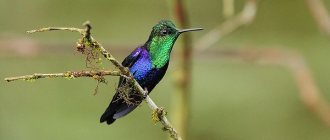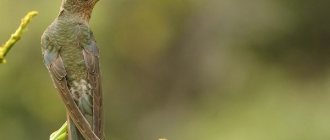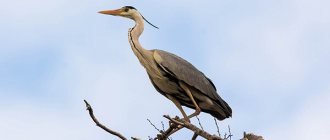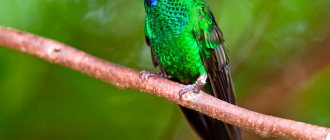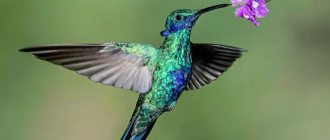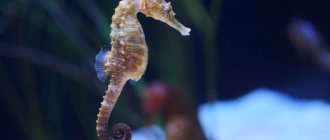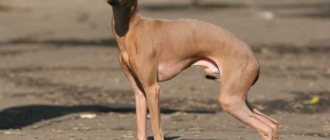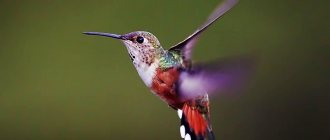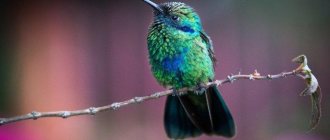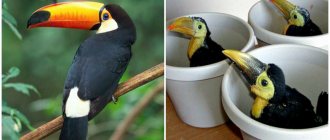- Wild animals
- >>
- Birds
The hummingbird is a miniature bird, flashing its plumage like a scattering of sapphires.
She impresses with her aerial acrobatics, flying quickly, then instantly stopping, soaring and flying up, down or backwards and even upside down, gracefully controlling all stages of flight. They beat their wings extremely quickly (about 80 times per second), resulting in a buzzing sound. The babies fascinated the first Europeans to arrive in North America. Many naturalists of the time wondered whether hummingbirds were a cross between a bird and an insect.
Origin of the species and description
Photo: Hummingbird
Over the past 22 million years, hummingbirds have rapidly evolved into hundreds of different species. Their development history is amazing. It carries small birds from one continent to another and then back again, all the while diversifying and developing their distinctive features.
The branch leading to modern hummingbirds arose about 42 million years ago, when the ancestors of hummingbirds split off from their relatives, the swifts, to form a new species. This probably occurred in Europe or Asia, where fossils similar to hummingbirds were found dating back to 28-34 million years ago.
Video: Hummingbird
These birds found their way to South America through Asia and the Bering Strait to Alaska. There are no descendants of them left on the Eurasian continent. Once in South America about 22 million years ago, birds quickly created new ecological niches and evolved new species.
Interesting fact! Genetic analysis shows that hummingbird diversity continues to increase, with new species emerging at rates faster than extinction rates. Some locations contain more than 25 species in the same geographic area.
It remains a mystery how hummingbirds managed to get along in South America. Because they depend on the plants that evolved with them. There are now 338 recognized species, but the number could double in the next few million years. Traditionally, they were divided into two subfamilies: hermits (Phaethornithinae, 34 species in 6 genera) and typical (Trochilinae, all other species). However, phylogenetic analyzes indicate that this division is imprecise and there are nine major groups.
Songs or shouts
It's hard to believe that these babies of the bird world can sing loud enough. Although it is quite difficult to call their sounds singing, they rather resemble a short and aggressive cry. Such sounds can always be heard in the places where this family lives, since in this way they notify others that this feeding territory is already occupied. People find such songs unpleasant to hear.
Some species produce sounds in a frequency range that the human ear cannot detect. Only the nightingale saberwing's singing resembles the vocals of a nightingale, for which a beautiful species name was coined.
But there is a season when hummingbirds are embarrassed to sing: this trend can be seen during the molting period. Apparently, for inspiration they need an exceptional concert costume, and these birds cannot boast of the state of their plumage at this time.
Appearance and features
Photo: Hummingbird bird
The hummingbird's distinctive features are its long beak, bright plumage, and humming sound. Most individuals are multi-colored, but there are also plain brown or even white albinos. The colors change with each reflection of light and give the feathers a metallic sheen. Only some of the spectrum of colors are visible to the human eye. Understanding the physical characteristics helps determine what makes these little ones unique:
- Size. Hummingbird is the smallest bird (5-22 cm). The bee hummingbird is the tiniest bird in the world. The male hummingbird is more colorful than the female, but the females are larger in size. The largest is the giant hummingbird. The weight of the bird's body is 2.5-6.5 g.
- Form. All members of the family share the same external features, which makes them instantly recognizable. A short streamlined body, elongated wings and a narrow elongated beak.
- Beak. The needle-like beak is the bird's most unique physical characteristic. It is elongated and thin relative to the size of the hummingbird, and is used as a tube for licking nectar from flowers with its long tongue.
- Wings. Long, narrow, tapered for increased maneuverability in the air. They have a unique design. The wing joints (shoulder + elbow) are located close to the body, this allows the wings to tilt and turn. This has a positive effect on the hummingbird’s maneuverability when changing flight direction and hovering.
- Paws. Tiny and short, they are extremely small, which is why birds don't walk. They have four toes with an anisodactyl arrangement of the fourth toe pointing backwards. This makes it possible to grab branches and sit. Birds can make awkward sideways jumps, but the main thing for hummingbirds is flight.
- Plumage. Most types have rich colors and bold patterns. The brightly colored throat in the form of a frill collar is a key feature of the male in shape and color. The structure of the arrangement of feathers on the body consists of 10 levels. The coloration of females is simpler, but in some species it contains rainbow colors.
The heart rate of hummingbirds varies from 250 to 1200 beats per minute. At night, during torpor, it decreases and ranges from 50 to 180 beats per minute. The bird's heart is twice the volume of the stomach and occupies ½ of the body cavity. The hummingbird's maximum flight speed is 30/60 mph.
Beak like a fishing rod
Hummingbirds have a big sweet tooth. 90% of their diet is nectar, with a little more pollen. Since insects are occasionally found on the menu, this family can be classified as predators, although given their size this sounds very unexpected.
What flowers these creatures will sit on depends on the shape of their beak: for short corollas a small beak is suitable, but an elongated and narrow corolla can only be penetrated with a long beak, like a fishing rod. Nectar flows through a long tongue in the form of a tube. In a split second, the tongue analyzes the nectar for the presence of amino acids necessary for the bird, like a modern chemical laboratory.
Where do hummingbirds live?
Photo: Hummingbird small bird
Hummingbirds are native to the New World. They have long settled in South, North and Central America. Most species are found in tropical and subtropical regions and the Caribbean islands. Numerous colonies are found in mid-mountain areas and only a few species are seen in temperate latitudes.
Often, the range of some species covers one valley or slope, while other representatives of the genus have habitats that stretch in a narrow strip along the eastern or western slope of the Andes; there are also many island endemics.
The richest area for various species of hummingbirds is the zone of transition from the mountains to the foothills at an altitude of 1800–2500 m with a constant daily temperature of 12–16 °C. The rich flora is represented by creeping plants, shrubs, ferns, orchids, trees, bromeliads, etc. Hummingbirds in this area have a wide variety of body sizes and beak shapes.
Curious! Hummingbirds are very intelligent and are able to remember places and individuals from year to year.
The tiny hummingbird can fly an impressive 2,000 miles to migrate, sometimes traveling up to 500 miles continuously. They usually fly south in winter and north in summer. To accomplish this incredible migratory feat, they feed heavily and double their body weight.
Ruby-throated hummingbirds have the largest breeding range of any North American species. The black-chinned hummingbird is the most adaptable species in North America. Found from deserts to mountain forests and from urban areas to pristine natural areas.
What do hummingbirds eat?
Photo: Hummingbird animal
Birds, in the process of evolution, have developed unique adaptive abilities for feeding. They mainly eat flower nectar, tree sap, insects and pollen. Rapid breathing, increased heart rate and high body temperature require frequent feeding and huge amounts of food every day.
Hummingbirds eat a variety of insects, including mosquitoes, fruit flies and midges in flight or aphids on leaves. The lower beak can bend up to 25°, flaring out at the base. Hummingbirds hover among swarms of insects to make feeding easier. To meet their energy needs, they drink nectar, the sweet liquid inside flowers.
Fun fact! Like bees, hummingbirds, unlike other birds, can estimate the amount of sugar in nectar and will reject flowers that produce nectar with less than 10% sugar content.
They don't spend all day flying because the energy cost would be prohibitive. Most of the activity consists of sitting or sitting down. Hummingbirds eat a lot, but in small amounts, and consume about half their body weight in nectar each day. They digest food quickly.
They spend somewhere between 15–25% of their time feeding and 75–80% sitting and digesting. They have a long tongue, which they use to lick food at a speed of up to 13 licks per second. The two halves of the beak have a distinct overlap. The bottom half fits tightly to the top.
When a hummingbird feeds on nectar, its beak opens only slightly, allowing its tongue to dart inside the flowers. When catching insects in flight, the hummingbird's jaw bends downwards, widening the opening for successful capture. To maintain their energy, birds feed 5 to 8 times per hour.
How long do they live in the wild?
Ornithologists determine age by tracking ringed birds. Observations show that due to their small size and high metabolic rate, the life expectancy of hummingbirds in natural conditions is 6-9 years.
In zoos, with proper nutrition, hummingbirds live up to 14 years.
Keeping birds at home in cages or aviaries is not suitable. They need a special diet and special conditions to which they are accustomed in nature. Without these requirements, hummingbirds do not do well in captivity. Their lifespan is significantly reduced.
Features of character and lifestyle
Photo: Hummingbird Red Book
Hummingbirds fly in any direction and hover steadily in place. Few other birds can do something like this. These birds never stop beating their wings, and their tiny size makes them look like large bumblebees.
They fly mostly in a straight line unless the male performs a male display flight. Males can fly in a wide arc—about 180°, which looks like a semicircle—swinging back and forth as if suspended from the end of a long wire. Their wings hum loudly at the bottom of the arc.
Curious! Hummingbirds contain special cells in their feathers that act like prisms when exposed to sunlight. The light is split into long waves, creating iridescent colors. Some hummingbirds use these bright colors as a territorial warning.
Hummingbirds have the highest metabolism of any non-insect animal. The increased metabolism allows for rapid wing movement and an extremely high heart rate. During flight, their oxygen consumption per gram of muscle tissue is about 10 times higher than that of elite athletes.
Hummingbirds can dramatically reduce their metabolic rate at night or if they are having trouble finding food. They put themselves into a state of deep sleep. They have a fairly long lifespan. Although many die within the first year of life, those who survive can live up to ten years and sometimes more.
Social structure and reproduction
Photo: Hummingbirds
The beginning of the hummingbird mating season is associated with the period of mass flowering and varies greatly among different species and in different regions. Nests are found in habitats throughout the year. Hummingbirds are polygamous individuals. They create pairs only to fertilize eggs. Males stay near the female for a short time and do not participate in other reproductive duties.
During the period of sexual synchronization, males present themselves to the female through singing and a bright appearance. During the breeding season, some of them sing during the day about 70% of the time. Some species display loud, intermittent sounds. During mating flights, hummingbirds can beat their wings 200 times per second, making a humming sound.
Most birds build cup nests on the branches of trees or shrubs, but many tropical species attach their nests to leaves and even rocks. The size of the nest varies depending on the specific species - from miniature (half a walnut shell) to larger ones (20 cm in diameter).
On a note! To bind nest materials together and secure its structure, birds often use cobwebs and lichens. The unique properties of the materials make it possible for the nest to expand as the young chicks grow.
Females lay 1-3 eggs, which are relatively large compared to the body of an adult. Incubation ranges from 14 to 23 days, depending on the type of bird and the ambient temperature. The mother feeds the chicks with small arthropods and nectar. Young individuals begin to fly 18-35 days after hatching.
Natural enemies of hummingbirds
Photo: Hummingbird animal
Many people have fallen in love with the gorgeous little precious birds and are hanging feeders to provide them with sugar water. Thus trying to help prevent the loss of one of nature's most amazing birds. However, cats are often found near homes, as pets and hummingbirds become their victims.
Interesting fact! In addition to speed and excellent vision, hummingbirds can protect themselves with the help of their tail. If a hummingbird is caught from behind by a predator, the loosely attached tail feathers can quickly stretch out. This gives the bird a chance to survive. Moreover, these wonderful feathers grow back quickly.
Hummingbirds use webs to create their nests. Therefore, sometimes they get caught in it and cannot free themselves, becoming prey to spiders and large insects.
In addition, hummingbird predators are:
- Mantises - in particular, the Great Chinese Mantis was imported from China and released into gardens as an insect predator, but has also become a predator of hummingbirds.
- Ktyri, which wrap their wings around a hummingbird, preventing it from flying away. This kills hummingbirds without much of a problem.
- Frogs. Hummingbirds have been found in the stomachs of frogs. Apparently, they caught them near water sources.
- Large birds: hawks, owls, crows, orioles, gulls and herons can be predators. However, hummingbirds are aggressive and often fight off large birds in their territory.
- Snakes and lizards are also dangerous for these birds.
Hummingbirds are very agile, constantly on the lookout for danger and can quickly fly away from any predator.
Population and species status
Photo: Little hummingbird
It is difficult to estimate population size because there are many different species spanning large geographic areas. We know from history that hummingbirds have been killed for their feathers, but today birds face equally devastating threats.
Changes in the Earth's temperature due to climate change are affecting hummingbird migration patterns, resulting in different species being found in places far outside their normal range where food is difficult to find.
Hummingbirds are popular all over the world. Many people make hummingbird feeders or grow flowers that attract hummingbirds during the warmer months when they make long flights. Hummingbird enthusiasts do everything they can to make sure every backyard, park and garden has a wonderful place for these wonderful birds.
There are laws against capturing hummingbirds in any form. However, some human activities can be a threat to birds. The main problem is the decrease in habitat as people continue to build cities, parking lots, etc.
Weather is another challenge for hummingbirds. Whatever the reason, our climate is changing. Storms threaten bird migration. A lack of wildflowers due to irregular blooms, fires and floods is taking its toll on birds.
Magic wing
It is clear that with such a small weight, any creature floating in the air can be blown away by even a small breath of wind. However, in the places where this family lives, people know very well that the wind is not an obstacle to the flight of these persistent little ones.
The question of how it is possible to maintain a stable position in the air with such a low weight is of interest not only to biologists, but also to technical engineers. This topic was even discussed at an international council, the main figure of which was hummingbirds.
The fact is that in most birds, when flying, the wings move up and down, due to which the body rises into the air. But hummingbirds have a different flight principle: their wings describe a figure eight, during which they can direct air flows downward to rise or upward to descend.
The direction of movement is constantly adjusted so that the body position remains stable no matter where the wind flows. To do this, the angle of rotation of the wings changes almost every second, and all this happens unconsciously, as during the operation of the smartest automatic system.
Scientists became interested in this device and wanted to create an artificial wing of this type. Robotic wings are needed to create modern ornithopters - devices that facilitate ornithological research in the air. In addition, the military is keenly interested in such technologies, since small, lightweight, wind-resistant flying devices would facilitate reconnaissance operations.
Seeing how these birds fly, you can freeze in place in amazement. The fact is that they are able to soar not only with their heads forward, like all other birds, but also with their tails forward. Having seen this at least once, a person will no longer be able to erase the unusual picture from his memory, this manner of movement looks so unusual.
